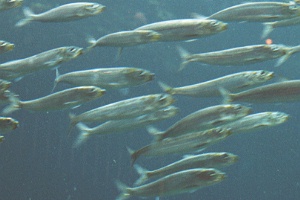|
Chagres Formation
The Chagres Formation (Tc)Geologic Map, 1980 is a geologic formation in the Colón Province of central Panama. The sandstones and siltstones were deposited in a shallow marine environment and preserve fossils dating back to the Middle to Late Miocene (Tortonian to Messinian, Clarendonian to Hemphillian in the NALMA classification) period. Description The Chagres Formation is exposed in the northern part of the Panama Canal Zone. The formation overlies and partly overlaps the Gatún Formation. The outcrop area lies entirely west of the Panama Canal, extending from the Canal Zone southwestward along the Caribbean coast, about southwest of Colón. Calcareous strata at the base of the formation throughout most of the outcrop area in the Canal Zone constitute the Toro limestone member.Woodring, 1957, p.47 The name Chagres Sandstone was proposed by MacDonald in 1919 for the sandstone forming the hills that overlook the coast from Toro Point to the mouth of the Chagres River. The ... [...More Info...] [...Related Items...] OR: [Wikipedia] [Google] [Baidu] |
Formation (stratigraphy)
A geological formation, or simply formation, is a body of rock having a consistent set of physical characteristics (lithology) that distinguishes it from adjacent bodies of rock, and which occupies a particular position in the layers of rock exposed in a geographical region (the stratigraphic column). It is the fundamental unit of lithostratigraphy, the study of strata or rock layers. A formation must be large enough that it can be mapped at the surface or traced in the subsurface. Formations are otherwise not defined by the thickness (geology), thickness of their rock strata, which can vary widely. They are usually, but not universally, tabular in form. They may consist of a single lithology (rock type), or of alternating beds of two or more lithologies, or even a heterogeneous mixture of lithologies, so long as this distinguishes them from adjacent bodies of rock. The concept of a geologic formation goes back to the beginnings of modern scientific geology. The term was used by ... [...More Info...] [...Related Items...] OR: [Wikipedia] [Google] [Baidu] |
Fossils
A fossil (from Classical Latin , ) is any preserved remains, impression, or trace of any once-living thing from a past geological age. Examples include bones, shells, exoskeletons, stone imprints of animals or microbes, objects preserved in amber, hair, petrified wood and DNA remnants. The totality of fossils is known as the ''fossil record''. Paleontology is the study of fossils: their age, method of formation, and evolutionary significance. Specimens are usually considered to be fossils if they are over 10,000 years old. The oldest fossils are around 3.48 billion years old to 4.1 billion years old. Early edition, published online before print. The observation in the 19th century that certain fossils were associated with certain rock strata led to the recognition of a geological timescale and the relative ages of different fossils. The development of radiometric dating techniques in the early 20th century allowed scientists to quantitatively measure the absolute ... [...More Info...] [...Related Items...] OR: [Wikipedia] [Google] [Baidu] |
Carcharhinus Plumbeus
The sandbar shark (''Carcharhinus plumbeus'') also known as the brown shark or thickskin shark, is a species of requiem shark, and part of the family Carcharhinidae, native to the Atlantic Ocean and the Indo-Pacific. It is distinguishable by its very high first dorsal fin and interdorsal ridge. It is not to be confused with the similarly named sand tiger shark, or ''Carcharias taurus.'' Description The sandbar shark is one of the biggest coastal sharks in the world, and is closely related to the dusky shark, the bignose shark, and the bull shark. Its dorsal fin is triangular and very high, and it has very long pectoral fins. Sandbar sharks usually have heavy-set bodies and rounded snouts that are shorter than the average shark's snout. Its upper teeth have broadly uneven cusps with sharp edges. Its second dorsal fin and anal fin are close to the same height. Females reach sexual maturity around the age of 13 with an average fork-length (tip of the nose to fork in the tail) ... [...More Info...] [...Related Items...] OR: [Wikipedia] [Google] [Baidu] |
Carcharhinus Cionei
''Carcharhinus'' is the type genus of the family Carcharhinidae, the requiem sharks. One of 12 genera in its family, it contains over half of the species therein. It contains 35 extant and eight extinct species to date, with likely more species yet to be described. Species Extant T Type species Fossil See also * List of prehistoric cartilaginous fish genera This list of prehistoric cartilaginous fish genera is an attempt to create a comprehensive listing of all genera that have ever been included in the class chondrichthyes ''and'' are known from the fossil record. This list excludes purely vernacul ... References Bibliography * * * * * * * {{Taxonbar, from=Q312359 Shark genera Extant Eocene first appearances Taxa named by Henri Marie Ducrotay de Blainville ... [...More Info...] [...Related Items...] OR: [Wikipedia] [Google] [Baidu] |
Carcharhinus Brachyurus
The copper shark (''Carcharhinus brachyurus''), bronze whaler, or narrowtooth shark, is a species of requiem shark, family Carcharhinidae, and the only member of its genus found mostly at temperate latitudes. It is distributed in a number of separate populations in the northeastern and southwestern Atlantic, off southern Africa, in the northwestern and eastern Pacific, and around Australia and New Zealand, with scattered reports from equatorial regions. This species can be found from brackish rivers and estuaries, to shallow bays and harbors, to offshore waters deep or more. Females are found apart from males for most of the year, and conduct seasonal migrations. A large species reaching long, the copper shark is difficult to distinguish from other large requiem sharks. It is characterized by its narrow, hook-shaped upper teeth, lack of a prominent ridge between the dorsal fins, and plain bronze coloration. Feeding mainly on cephalopods, bony fishes, and other cartilaginous fis ... [...More Info...] [...Related Items...] OR: [Wikipedia] [Google] [Baidu] |



